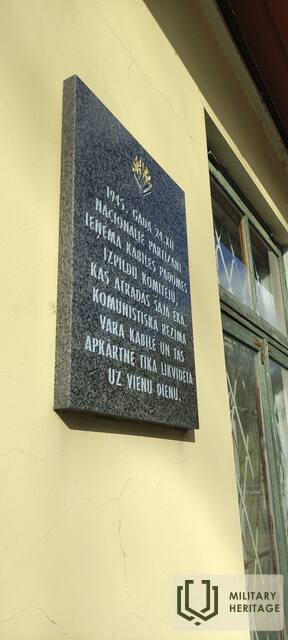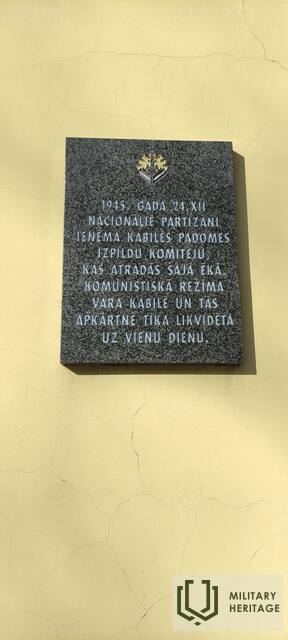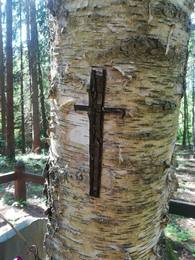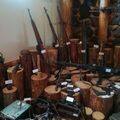The capture of Kabyle at the turn of 1945-1946
One of the most striking manifestations of post-war armed resistance in Kurzeme was the capture of Kabile on Christmas 1945 and the subsequent battle near the Āpuznieki house on January 1, 1946.
The former Kabile parish house housed the local executive committee and a police station, where about 25 armed militiamen and destroyers were on duty at night. The pretext for the attack was the desire to release the forest brother Rūdolfs Eglītis, who had been detained the previous day and who had already been transferred to the Kuldīga police station during the night.
In the early morning of December 24, 1945, 20 armed partisans split into several groups, cut telephone wires, blocked roads, and positioned themselves in outposts 300 meters from the center of Kabile.
After opening fire, a separate assault group broke into the police premises through the windows, knocking them out with all the frames. The policemen were placed against the wall with their hands raised and a guard was left next to them, while the other partisans rushed up to the second floor, where the fighters of the Kabiles platoon of the Kuldīga destroyer battalion had fled. Although there was an opportunity to kill them using hand grenades, they did not do so so as not to harm the family of the partisan supporter - the secretary of the executive committee, who lived right next door.
According to a later report by the head of the Kuldīga district department of the Ministry of State Security of the Latvian SSR, Sobachkin, on December 24, 1945, in Kabile, the operational officer Dambis and driver Puriņš of the Kuldīga district department of the People's Commissariat of State Security (VDTK) and the destroyers Liepiņš and Znotiņš fell from the bullets of the forest brothers, while the senior lieutenant Kirsanovs, the operational officer Baļuļins, the destroyer Galeckis and the militia officer Zieds of the VDTK Kuldīga district department were wounded. The local party orderly Budanska, who had hidden behind a stove, managed to survive the clash.
The partisans took the weapons they had captured as trophies, confiscated the executive committee's documents and typewriters, and released the people in custody.
How the partisans drove the occupiers out of Kabila in 1945/1946 / Article (lsm.lv)
https://www.lsm.lv/raksts/dzive--stils/vesture/ka-partisans-19451946-gadumija-padzina-okupantus-no-kabiles.a490270/
Related timeline
Related topics
Related objects
National Partisans battle site near the Apūznieki home
On 1 January 1946, one of the biggest battles between the national partisans and the Cheka, or Soviet occupation State Security Committee, took place between Kabila and Renda near the "Apūznieki" houses. The partisans, among whom was the commander of the group, Fricis Kārkliņš, went after hay on the horses of the forest brigades. He left Ēvalds Pakulis as commander. The scouts reported that a Cheka unit was approaching the dugouts. Pakulis sent a partisan detachment - 25 well-armed men - to meet them. The bullets of the enemy wiped out the lives of three men - Kārlis Kristolds, Emītis Šmits and Ādolfs Kūrējs - but about 50 men fell on the Cheka side. Two of the fallen men are buried in the forest where these events once took place, and a memorial to them has been created.
Today, new bunkers are being discovered in the forests, which once sheltered almost 20 000 people who did not support the Soviet occupation and were uncooperative, or who hid in the forests for other reasons, such as fear for their lives, safety, etc.
Museum of the National Resistance Movement in Renda
The museum is located a few kilometres from the centre of Renda parish. The exhibit tells about the 50-year-long resistance movement in Latvia: resistance to the first Soviet occupation, resistance to the Nazi German occupation, and the armed and non-violent resistance to the Soviet occupation. The exhibit is located in two buildings. The first building houses evidence of the first Soviet occupation and German occupation. The exhibit showcases a restored barn building where the focus lies on the National Partisan War. Between the two buildings there is a bunker with an authentic layout and trenches used by soldiers. Located near the museum in Renda, excavations, blindages and an obstacle course serve as a training ground for youth guards and anyone interested. Visits must be booked in advance.
One of the largest battles of the national partisans, called the Āpūznieki Battle, took place in January 1946 not far from here. The battle saw the Kabile National Partisan Group overpower much larger forces of the occupying power. Featuring information stands, the battle site is now home to a rest area.









